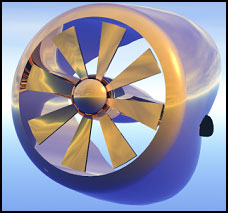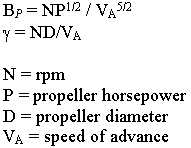 |
 |
 |
 |
Transport |  |
 |
 |
 |
 |
Introduction Pressure Hull Exostructure Propulsion Power Source Ballast Life Support Communication Navigation Docking Surface Support Operation Schedule Artistic Picture |
 |
 |
 |
 |

LEEAMITe's Systems
Propulsion
- Propellers
There will be two propellers, one on each side of LEEAMITe. Each will be 1.75 meters in diameter. They will be Kort Nozzle propellers, which are screw propellers fitted with a specially designed nozzle. The screw propeller is the most efficient means of obtaining propulsive force, measured to be about 75-80% efficient. The nozzle increases efficiency by creating a negative pressure forward of the propellers plane of rotation, and a positive pressure aft, resulting in forward thrust.
- Movement
The propellers will provide "thrust" and "yaw" movement. This includes the ability to maneuver vertically up or down and traversing and changing course. The two reversible propellers will be capable of being rotated 360 degrees in the vertical plane. The NEMO used this propeller arrangement for its propulsion. Like LEEAMITe, the NEMO had a similar shape and low center of gravity, which held it in a vertical position. Other submersibles that used propellers that rotated 360 degrees are the Shinkai and the Alvin.
- The Motor
A DC electric motor will initiate and maintain the motion of the propellers. It will rotate a shaft that turns the screw-type propellers. To protect the motor from contact with seawater, it will be hermetically sealed. This means that it will be enclosed in a pressure resistant case. Because the motor is DC, the motor can be operated directly from the battery without the use of an inverter. DC Motors have better speed control than AC and a higher torque. The LEEAMITe motor will require maintenance after each dive.
- Calculations
Effective horsepower in water is determined by
 -
- curves:
curves:
To obtain the open water efficiency, the intersection of the
 and the
and the  curves is calculated to obtain open water efficiency.
curves is calculated to obtain open water efficiency.The machinery efficiency is defined as:

PHP = propulsive horsepower
SHP = shaft horsepower
n = shaft rotation (revolutions/s)
Q = torque delivered (ft lb)EHP - Effective horsepower is the product of the total resistance (
 ) and the
submersible speed (V) expressed in units of horsepower. The total
resistance is estimated either by the drag calculations or by model tests.
) and the
submersible speed (V) expressed in units of horsepower. The total
resistance is estimated either by the drag calculations or by model tests.
- References
1. Allmendinger, E. E. Submersible Vehicle Systems Design. The Society of Naval Architects and Marine Engineers. N.J. 1990.
